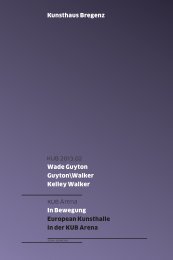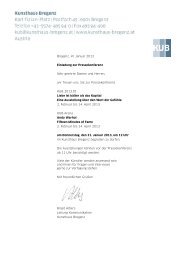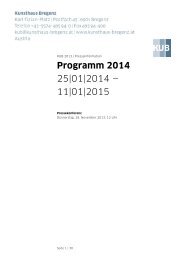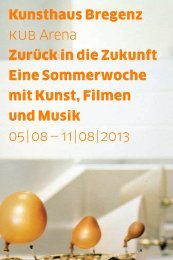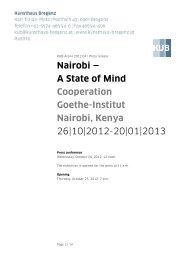Florian Pumhösl Spatial Sequence - Kunsthaus Bregenz
Florian Pumhösl Spatial Sequence - Kunsthaus Bregenz
Florian Pumhösl Spatial Sequence - Kunsthaus Bregenz
You also want an ePaper? Increase the reach of your titles
YUMPU automatically turns print PDFs into web optimized ePapers that Google loves.
KUB 2012.04 | Press release<br />
<strong>Florian</strong> <strong>Pumhösl</strong><br />
<strong>Spatial</strong> <strong>Sequence</strong><br />
26|10|2012-20|01|2013<br />
Press conference<br />
Wednesday, October 24, 2012, 12 noon<br />
The exhibition is opened for the press at 11 a.m.<br />
Opening<br />
Thursday, October 25, 2012, 7 p.m.<br />
Page 1 | 10
<strong>Florian</strong> <strong>Pumhösl</strong> (born 1971, lives in Vienna) is a rarity in<br />
his generation of Austrian artists in having rigorously and<br />
cogently developed an independent abstract formal and<br />
pictorial language. For all its rigor of expression this language<br />
wields a highly impressive range of contemporary<br />
references and has immense visual potential. His international<br />
career began at a young age—at the time of his<br />
participation in the legendary group exhibition Backstage at<br />
the Hamburg Kunstverein together with Dorit Margreiter<br />
and Mathias Poledna in 1993, <strong>Florian</strong> <strong>Pumhösl</strong> was just<br />
twenty-two years old. With the symbolic support of friends,<br />
the artist trio’s contribution to that show pro-vided for the<br />
removal of all the institution’s door locks during the show,<br />
thus opening the exhibition hall’s accessibility, both really<br />
and metaphorically. If today, almost twenty years later,<br />
such clearly articulated reflection on the mechanisms of the<br />
art system and its institutions seems to be more covert in<br />
his works, yet engagement with the specific exhibition site<br />
and its institutional features is of great significance for him,<br />
now as then. In this respect, his big solo exhibition at the<br />
Museum Moderner Kunst Stiftung Ludwig Vienna in early<br />
2011 was an eminent example. Here, by means of a<br />
architectural route, <strong>Pumhösl</strong> set up an exemplary dialog<br />
between the brilliantly bright exhibition space, the so-called<br />
white space, and the black box used for film screenings. In<br />
addition to numerous solo shows in public museums and art<br />
halls including in Cologne, Geneva, and Amsterdam, in the<br />
past ten years he has participated in many major art events,<br />
such as the São Paulo Biennale, the Venice Biennale, and<br />
documenta 12 in 2007.<br />
<strong>Florian</strong> <strong>Pumhösl</strong>’s wide-ranging oeuvre, which includes<br />
films, installations, objects, and glass painting, is characterized<br />
by great reduction in terms of artistic expression<br />
while nevertheless, despite this frugality, creating a strongly<br />
abiding presence. In recent years, he has frequently produced<br />
series, such as his Bewegliche Bühne [Moving Stage],<br />
consisting of glass plates cut into various shapes, which he<br />
presents as a kind of staging in different configurations on<br />
sets of four supporting plates.<br />
Another cycle of pictures titled Diminution consists of thin<br />
glass plates painted with black lines in nine two-to-six piece<br />
elements. Among other things, <strong>Pumhösl</strong> alludes to Hans<br />
Richter’s Dada Heads in these works.<br />
His central engagement with the historical formal vocabulary<br />
of modernism and its specific thematic issues is<br />
typical of <strong>Florian</strong> <strong>Pumhösl</strong>’s work. What interests him<br />
frequently is not only the genealogical derivation of a<br />
particular form, but also its social and political setting.<br />
His projects are often preceded by lengthy and involved<br />
research that can take him to countries such as Japan,<br />
Tanzania, or, as recently, to the Finnish-Russian region of<br />
Karelia.<br />
Page 2 | 10
<strong>Florian</strong> <strong>Pumhösl</strong> will be presenting a new series at the<br />
<strong>Kunsthaus</strong> <strong>Bregenz</strong> titled Räumliche Sequenz [<strong>Spatial</strong><br />
<strong>Sequence</strong>] specially produced for the occasion. The work<br />
consists of plaster panels in three different sizes grouped in<br />
threes, the order of each trio beginning with the smallest<br />
and ending with the largest format. The progression of the<br />
45-piece series of 15 subjects, subtitled Cliché, takes its<br />
lead from the Bauhaus artist László Moholy-Nagy’s enamel<br />
pictures. In contrast to Moholy-Nagy, who delegated the<br />
task in the case of his telephone pictures to a specialist firm,<br />
<strong>Pumhösl</strong> himself applies the formal effects to his panels<br />
using what he refers to as a cliché stamp.<br />
The printing procedure involved goes back to the start<br />
of the nineteenth century when stamp-like printing dies<br />
were developed. A special feature of these dies, known in<br />
French as »cliché«, in English stereotype, was that they<br />
could be indefinitely reused. Concerning his new series for<br />
the <strong>Bregenz</strong> exhibition, <strong>Pumhösl</strong> has written: »For these<br />
works I had panels made of plaster, a homogenous mineral<br />
material, on which I applied paint using a cliché stamp. The<br />
transparent cliché makes it possible to design the picture<br />
support on the visible side. An idea I find important is that<br />
an abstract picture is, from the outset, a reproduction<br />
(possibly of something ideal) and that its peculiar qualities<br />
allow this to be grasped.«<br />
The formal patterns of indigo blue that rhythmicize the<br />
plaster panels are no less important than how they are<br />
applied. Against the backdrop of <strong>Pumhösl</strong>’s interest in early<br />
Latin-American woven patterns and their reception by<br />
modernist artists, for instance, a discursive field opens up<br />
combining extra-European influences, the importance of<br />
design, and seriality in art. Seriality comes across especially<br />
clearly through the repetition of line patterns within a trio<br />
and the potential for reproducing the same by means of the<br />
cliché stamp.<br />
Moreover, the line groupings on the individual panels, with<br />
their potential for musical interpretation, point to a central<br />
aspect of historical abstraction. And the positioning of the<br />
panels in space, the distances and open areas <strong>Pumhösl</strong> has<br />
set between them, also recall a time-based sequence and in<br />
this sense resemble a musical score.<br />
Page 3 | 10
KUB Billboards<br />
Michael Part and <strong>Florian</strong> <strong>Pumhösl</strong><br />
15|10|2012 — 20|01|2013<br />
Seestraße <strong>Bregenz</strong><br />
The Billboards extend the principle of seriality into ur-<br />
ban space. The 6-part series cooperatively produced by<br />
Michael Part and <strong>Florian</strong> <strong>Pumhösl</strong> reflects the influence of<br />
basic photographic principles on the abstract picture.<br />
The billboards in this case are defined as originals that<br />
employ the photographic process of cyanotype printing.<br />
In this Prussian blue printing process a support coated with<br />
an iron-based light-sensitive chemical is exposed to light,<br />
which turns it blue. The 3.3 x 3.3 meter textile squares are<br />
exposed to incident light for a constant period of time over<br />
several days, whereby ultimately the various meteorolog-<br />
ical conditions are what produce the picture. In a sense, the<br />
surfaces reflect what the pictures themselves saw.<br />
Page 4 | 10
KUB Publication<br />
<strong>Florian</strong> <strong>Pumhösl</strong><br />
<strong>Spatial</strong> <strong>Sequence</strong><br />
The <strong>Florian</strong> <strong>Pumhösl</strong> publication presents not just the new<br />
series of works on show at the <strong>Kunsthaus</strong> <strong>Bregenz</strong>, it also<br />
catalogues all of his exhibitions since 1993. For <strong>Pumhösl</strong>,<br />
born 1971 in Vienna, the exhibition is his most important<br />
medium. The publication presents his works chronological-<br />
ly in the context of their respective exhibitions, with illus-<br />
trations, dates, and in part explanatory texts on individual<br />
works.<br />
The American art historian Juli Carson and Berlin-based<br />
André Rottmann, both of whom have followed <strong>Pumhösl</strong>’s<br />
creative work for many years, engage knowledgeably in<br />
their essays with his oeuvre, his theoretical considerations,<br />
formal vocabulary, and his working techniques. Yilmaz<br />
Dziewior’s contribution confines itself to the <strong>Bregenz</strong><br />
exhibition and its conceptual background.<br />
<strong>Florian</strong> <strong>Pumhösl</strong><br />
<strong>Spatial</strong> <strong>Sequence</strong><br />
Works in Exhibitions<br />
1993 — 2012<br />
Edited by Yilmaz Dziewior<br />
Graphic design: Yvonne Quirmbach, Berlin<br />
Essays by Juli Carson, Yilmaz Dziewior, André Rottmann<br />
German | English<br />
Ca. 380 pages<br />
18 x 23 cm<br />
Hardcover<br />
Due out: December 2012<br />
52.– EUR<br />
KUB Online-Shop<br />
www.kunsthaus-bregenz.at<br />
Page 5 | 10
KUB Artist’s Edition<br />
<strong>Florian</strong> <strong>Pumhösl</strong><br />
Gauze Panel<br />
Exclusive special editions for the <strong>Kunsthaus</strong> <strong>Bregenz</strong> are a<br />
result of close collaboration with artists and their<br />
processes of production.<br />
<strong>Florian</strong> <strong>Pumhösl</strong>’s edition for <strong>Kunsthaus</strong> <strong>Bregenz</strong> is a<br />
photogram of cotton gauze. <strong>Pumhösl</strong> has previously<br />
referred to the »photographic character« of webbed<br />
structures, such as gauze webbing from the pre-Columbian<br />
cultures of Peru which for him, in their serial patterning<br />
and coloring, are of significant importance as one of the<br />
departure points for modern abstraction.<br />
Photogram on silver gelatin paper<br />
Ca. 60 x 50 cm<br />
Limited edition of 10 + 3 A. P.<br />
Numbered and signed<br />
1,800.– EUR<br />
Including 10% sales tax; packing and mailing charges extra<br />
Please contact: Caroline Schneider<br />
c.schneider@kunsthaus-bregenz.at<br />
Phone: +43-5574-485 94-444<br />
Page 6 | 10
<strong>Florian</strong> <strong>Pumhösl</strong><br />
Biography<br />
<strong>Florian</strong> <strong>Pumhösl</strong> was born in Vienna in 1971, where he<br />
lives and works. Recent exhibitions include: Mathias<br />
Poledna | <strong>Florian</strong> <strong>Pumhösl</strong>, Raven Row, London; 678,<br />
Museum moderner Kunst Stiftung Ludwig Wien (MUMOK),<br />
Vienna; <strong>Florian</strong> <strong>Pumhösl</strong>, Krobath, Vienna (all 2011);<br />
Diminution, Galerie Daniel Buchholz, Berlin (2010);<br />
Bewegliche Bühne, Kunstverein für die Rheinlande und<br />
Westfalen, Düsseldorf (2010); <strong>Florian</strong> <strong>Pumhösl</strong>, Lisson<br />
Gallery, London (2008); <strong>Florian</strong> <strong>Pumhösl</strong>, Galerie Daniel<br />
Buchholz, Cologne (2007); documenta 12, Kassel (2007);<br />
27th São Paulo Biennial, São Paulo (2006); <strong>Florian</strong><br />
<strong>Pumhösl</strong>. Animated Map, Neue Kunst Halle St. Gallen, St.<br />
Gallen (2005–2006); <strong>Florian</strong> <strong>Pumhösl</strong>, House of Art, Ceské<br />
Budejovice (2005).<br />
Page 7 | 10
Works in the exhibition<br />
Cliché 1-15, 2012<br />
15 picture groups, each 3 parts<br />
Dimensions:<br />
36.6 x 25.6 x 2 cm;<br />
73.4 x 51.4 x 2 cm;<br />
146.5 x 102.5 x 2 cm<br />
Stamping with oil pant on ceramic plaster<br />
Michael Part and <strong>Florian</strong> <strong>Pumhösl</strong><br />
15 | 10 | 2012—20 | 01 | 2013<br />
The large-scale image on canvas is part of a series<br />
realized for the KUB Billboards project titled<br />
15 | 10 | 2012—20 | 01 | 2013. For this series, the<br />
concept of seriality characterizing the exhibition is<br />
transferred to the cityscape. Furthermore the work<br />
created in a collaboration between Michael Part and<br />
<strong>Florian</strong> <strong>Pumhösl</strong> is a reflection on the influence of<br />
photography’s fundamental principles on the abstract<br />
image.<br />
Page 8 | 10
Partners and Sponsors<br />
The <strong>Kunsthaus</strong> <strong>Bregenz</strong> would like to thank its partners<br />
for their generous financial support and<br />
the cultural commitment that goes along with it.<br />
Page 9 | 10
Venue | Organizer<br />
<strong>Kunsthaus</strong> <strong>Bregenz</strong><br />
Director<br />
Yilmaz Dziewior<br />
Chief Executive<br />
Werner Döring<br />
Curator<br />
Rudolf Sagmeister<br />
Curator of the KUB Arena<br />
Eva Birkenstock<br />
Communications<br />
Birgit Albers | ext. -413<br />
b.albers@kunsthaus-bregenz.at<br />
Press photos to download<br />
www.kunsthaus-bregenz.at<br />
Art Education<br />
Kirsten Helfrich | ext. -417<br />
k.helfrich@kunsthaus-bregenz.at<br />
Publications | editions<br />
Katrin Wiethege | ext. -411<br />
k.wiethege@kunsthaus-bregenz.at<br />
Sales Editions<br />
Caroline Schneider | ext. -444<br />
c.schneider@kunsthaus-bregenz.at<br />
Opening hours<br />
Tuesday to Sunday 10 a.m.—6 p.m.<br />
Thursday 10 a.m.—9 p.m.<br />
26.10.2012, 10 a.m. – 6 p.m. | 01.11.12, 10 a.m. — 9 p.m. |<br />
08.12.12, 10 a.m. — 6 p.m. | 24. and 25.12.12 closed |<br />
26.12.12, 10 a.m. — 6 p.m. | 31.12.12, 10 a.m. — 2 p.m. |<br />
01.01.13, 2 p.m. — 6 p.m. | 06.01.13, 10 a.m. — 6 p.m.<br />
Page 10 | 10



